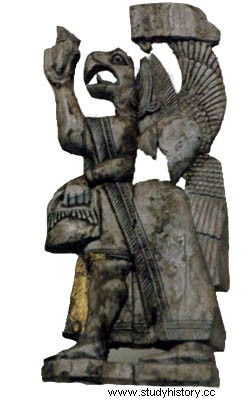 By 800 BC e. the threat of Assyrian enslavement loomed over the countries of Western Asia. It seemed that no one could resist the onslaught of the Assyrian armies - neither the weak kings of Babylon, nor the rulers of small "fragments" of the great Hittite state, nor the leaders of the tribes that inhabited the Iranian Highlands and Transcaucasia. The establishment of Assyrian domination meant a catastrophe for these peoples - after all, it would inevitably lead to the terrible ruin of the conquered countries and the mass extermination of people.
By 800 BC e. the threat of Assyrian enslavement loomed over the countries of Western Asia. It seemed that no one could resist the onslaught of the Assyrian armies - neither the weak kings of Babylon, nor the rulers of small "fragments" of the great Hittite state, nor the leaders of the tribes that inhabited the Iranian Highlands and Transcaucasia. The establishment of Assyrian domination meant a catastrophe for these peoples - after all, it would inevitably lead to the terrible ruin of the conquered countries and the mass extermination of people.
And yet, at a time when the power of the Assyrian state was truly enormous, in Asia Minor there was a people who not only decided to openly fight against a formidable enemy, but also almost won against him a deadly confrontation. We are talking about closely related tribes that inhabited the mountain valleys of Transcaucasia approximately in the area where the borders of Turkey, Iran and Armenia now converge. At that time, two strong unions of tribes, two states, Urartu and Manna, were formed on this territory. Their centers were the valleys of the mountain lakes Van and Urmia.
For the time being, the Assyrians did not pay attention to the events that took place on the northern outskirts of their state. The rulers of the world treated the Urartians as one of the numerous semi-wild tribes, believing that they should be kept in constant fear and punished for disobedience by punitive campaigns. The Assyrians clearly underestimated the Urartians. And later this people demonstrated their military, political, administrative and cultural talents. Assyrian positions in Asia Minor were not as strong as one might think. The kings of Urartu Menua (810-786 BC) and his son Argishti I (786-764 BC) began to use this skillfully.
The Urartians, like the Hittites, belonged to the Indo-European language family. The number of Indo-European peoples in Western Asia was constantly increasing due to constant migrations from the Balkans and from the Black Sea steppes; it can be said that a formidable Indo-European "cloud" hung over Assyria from the north. The appearance of nomadic peoples - Cimmerians and Scythians - in Transcaucasia and Asia Minor after 730 BC. e. gave this "cloud" even more menacing outlines. After the collapse of the Hittite kingdom (about 1200 BC), all these Indo-European peoples and tribes close in language, religion and culture lost their unifying center. The kings of Urartu took the place of the leader thanks to their energetic actions. Menua and Argishti I gradually took over the areas of Mutsatsir (east of the Assyrian capitals) and Northern Syria (west of them) inhabited mainly by Indo-European peoples. Thus, the Urartians cut off the main trade routes of the Assyrians, leaving them only one direction for military and commercial activity - the south. And there was recalcitrant Babylon, which already gave the Assyrian kings a lot of trouble.
 The weak point of the Assyrian state was its dependence on the import of raw materials (primarily metal ores) and finished metal products from Malaya Asia and Transcaucasia. The Urartians also had their own mines. In addition, Urartian steel, due to the skill of blacksmiths, was better than Assyrian. The Assyrians themselves preferred weapons made in Transcaucasia, and during campaigns against Urartu they tried to capture as many swords, daggers, and spearheads as possible.
The weak point of the Assyrian state was its dependence on the import of raw materials (primarily metal ores) and finished metal products from Malaya Asia and Transcaucasia. The Urartians also had their own mines. In addition, Urartian steel, due to the skill of blacksmiths, was better than Assyrian. The Assyrians themselves preferred weapons made in Transcaucasia, and during campaigns against Urartu they tried to capture as many swords, daggers, and spearheads as possible.
The Urartians were not only skillful blacksmiths, but also hardworking farmers, resourceful builders, and intelligent administrative officials. They were able to adopt the methods of irrigated agriculture from other peoples of the Ancient East and dug many complex, branched canals; some of them reached a length of 70 km. Irrigation of fields in mountain valleys made it possible to obtain high yields, accumulate huge food supplies and maintain a large number of soldiers and officials.
The Urartians founded many cities; some of them, such as Yerevan, still exist today. Individual cities had a regular rectangular layout; in front of their defensive walls, even the famous military art of the Assyrians turned out to be powerless. In 735 BC. e. Assyrian king Tiglath-Pileser III was unable to take the fortress in Tushpa. In 714 BC. e. his successor Sargon II, who devastated the entire territory of Urartu, did not even approach Tushpa, remembering the failure of his predecessor. The temples of the Urartians were quite different from their contemporary structures. The style of local architecture was a bit like the later Greek; inventions of Urartian engineers and builders subsequently spread widely in Asia Minor.
The Urartians needed all these talents when their kings, Argishti I and his son Sarduri II (764-735 BC), began to develop the vast lands located between the rivers Arak and Kura. The fact is that the vital centers of Urartu were located too close to the Assyrian possessions, and enemy troops could reach them in just a few transitions. Therefore, for Urartu, the transfer of state forges and granaries to the northern regions became a matter of life and death. In just a few decades, these lands were covered with orchards and vineyards; lively cities have grown in the mountain valleys.
It is difficult to find mistakes in the actions of the rulers of Urartu. Throughout almost the entire eighth century. BC e. they slowly and stubbornly "squeezed out" their formidable opponent, accumulating strength and avoiding a decisive battle. But the wounded lion jumped, and his jump turned out to be disastrous for the hunter. At the cost of extreme effort, the Assyrians still managed to defeat their prudent enemies.
There seemed to be several reasons for this disaster. In 745 BC. e. Tiglath-Pileser III ascended the Assyrian throne. A very energetic ruler, he suppressed internal unrest and carried out military reform. Assyria began to have a powerful army of hired, well-trained soldiers (see Art. "Assyria"). And the very first clashes between the Urartians and the Assyrian troops showed that the enemy of the Urartians was invincible. It was necessary to save what could still be saved. However, pride and unwillingness to abandon far-reaching plans turned out to be stronger than sober political calculation. The next king of Urartu, Rusa I (735-713 BC), decided to win by cunning where it was no longer possible to win by force. Distracting the Assyrian troops to the area of Lake Urmia, Rusa I tried to go behind their lines. But Sargon II was an experienced warrior and did not fall into the trap. The defeat of the Urartians was complete. Rusa fled to Tushpa and committed suicide.
Argishti, Sarduri, and Rusa seem to have been too slow to take advantage of their positions. Time worked rather against Urartu. At the end of the 8th - beginning of the 7th centuries. BC e. the unstable unity of the Indo-European peoples of Asia Minor and Transcaucasia under the leadership of Urartu was shaken by the appearance here of numerous nomadic tribes of the Cimmerians and Scythians, who caused considerable damage to the country. All attempts by the last kings of the Van kingdom, after the name of Lake Van, to subdue these peoples to their influence were unsuccessful; moreover, the Scythians eventually made an alliance with the Assyrians. The situation became hopeless; about 640 BC e. King of Urartu Sarduri III voluntarily recognized himself as subject to Assyria. And 30 years later Urartu was conquered by the Medes.
The history of Urartu, covering about three centuries (900-600 BC), is filled with bright and dramatic events. The confrontation between Urartu and Assyria played an important role in the history of Western Asia. It was the Urartians who forced the Assyrians to strain their strength, to rebuild the economy and society on a military footing. These measures made the Assyrian war machine unusually formidable, but deprived it of a solid foundation. The desperate struggle of the Kingdom of Van with the greatest of the Asian powers gave the necessary respite and time to create their own states to the young peoples of the Iranian Highlands - the Medes and Iranians. Who knows whether the civilization of Ancient Greece would have been able to develop later if the Assyrian armies had reached the Asia Minor coast of the Aegean Sea?
